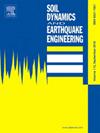Relationship between the diameter variation rate of prefabricated segmental tunnels and performance targets
IF 4.2
2区 工程技术
Q1 ENGINEERING, GEOLOGICAL
引用次数: 0
Abstract
The seismic performance design of prefabricated segmental tunnels plays a crucial role in contemporary underground structure design. To address the inadequacies in the current definition and description of seismic performance for prefabricated segmental tunnels, this study focuses on the division of structural performance levels for shield tunnel structures and determines the deformation limit values for their seismic and waterproof performance objectives. The performance objectives of the prefabricated segmental tunnels were divided into five levels: basic intact, operational, repairable, medium-repairable, and severely damaged. To obtain quantifiable performance indicators for prefabricated segmental tunnels that correspond to these performance objectives, this study investigated two adjacent ring segments of 19 sealed roof blocks at different positions based on four classic sites. Finite element models with refined details were utilized for the pushover analysis to obtain the capacity curves for the segment structures. Based on the relationship between the capacity curves and the performance objectives, the limit values of the diameter change rates for each case were determined using geometric plotting methods. The limit values of the diameter change rates for the prefabricated segmental tunnels corresponding to the five performance levels were determined to be 1/1850, 1/320, 1/180, 1/160, and 1/130. Finally, an index system was established for the seismic performance of prefabricated segmental tunnels. The proposed angle limits provide foundational guidance for the seismic design of prefabricated segmental tunnels.
预制管片隧道直径变化率与性能指标的关系
预制节段隧道抗震性能设计在当代地下结构设计中占有重要地位。针对目前预制管片隧道抗震性能定义和描述的不足,本研究重点对盾构隧道结构进行结构性能等级划分,确定其抗震和防水性能目标的变形限值。预制管片隧道的性能目标分为基本完好、可运行、可修复、中等可修复和严重损坏五个等级。为了获得与这些性能目标相对应的预制分段隧道的可量化性能指标,本研究基于四个经典场地,研究了19个密封顶板块在不同位置的两个相邻环形段。采用精细化有限元模型进行推覆分析,得到管片结构的承载力曲线。根据容量曲线与性能目标之间的关系,采用几何标绘法确定了每种情况下直径变化率的极限值。确定5个性能等级对应的预制管片隧道管径变化率极限值分别为1/1850、1/320、1/180、1/160和1/130。最后,建立了预制节段隧道抗震性能指标体系。提出的角度限值为预制节段隧道抗震设计提供了基础指导。
本文章由计算机程序翻译,如有差异,请以英文原文为准。
求助全文
约1分钟内获得全文
求助全文
来源期刊

Soil Dynamics and Earthquake Engineering
工程技术-地球科学综合
CiteScore
7.50
自引率
15.00%
发文量
446
审稿时长
8 months
期刊介绍:
The journal aims to encourage and enhance the role of mechanics and other disciplines as they relate to earthquake engineering by providing opportunities for the publication of the work of applied mathematicians, engineers and other applied scientists involved in solving problems closely related to the field of earthquake engineering and geotechnical earthquake engineering.
Emphasis is placed on new concepts and techniques, but case histories will also be published if they enhance the presentation and understanding of new technical concepts.
 求助内容:
求助内容: 应助结果提醒方式:
应助结果提醒方式:


